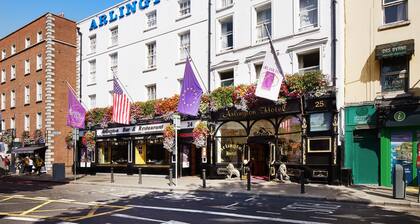Christ Church Cathedral, or to give it its full name, The Cathedral of the Holy Trinity, attracts many visitors, both as a fully functioning Anglican Church, but also for its fascinating 1,000 year history. It occupies the spiritual heart of the city, and as you make your way around Dublin, you won’t fail to hear the peal of its 19 enormous bells.
Its origins lie in the early part of the 11th century when it was founded by the Norse king of Dublin, Dúnán. The wooden church was built on the higher ground, overlooking the Viking settlements. Parts of today’s stone structure date back to the 1180s, when the wooden church was rebuilt, adding in the choir, transepts and the crypt. The tomb of Richard de Clare, or Strongbow, one of the instigators of the 12th century extension of the building, lies in the south isle of the nave however his body is no longer in situ. The crypt is open to visitors, and displays many fascinating artefacts, including the locally-nicknamed “Tom & Jerry”, a mummified cat and rat, which are mentioned in James Joyce’s work “Finnegans wake”.
During the medieval era, the church’s collection of holy relics made it a centre for pilgrimage. Items such as a miraculous speaking cross and a piece from Jesus’ crib drew worshipers from far afield. These items are no longer in the cathedral. Until recently, the 12th century Chapel of St Laurence O’Tool, the patron saint of Dublin, held the saint’s embalmed heart in an iron casket. Unfortunately this was stolen on 3rd March 2012.
The medieval character of the building was largely masked by an extensive Victorian restoration project. The tower was rebuilt, and buttresses and a choir screen were added in. The contrasting styles come together with the interactive Viking exhibition, Dublinia, housed in the covered Victorian Bridge of Sighs.
Round your visit off with a visit to the cathedral café and gift shop, or stay and hear the famous choir sing evensong.
Christ Church Cathedral is located on St Michael’s Hill, to the west of Temple Bar. The closest bus stop is Christchurch Place. No on-site parking is available. An admission fee is payable for both the cathedral and the Dublinia exhibition.










